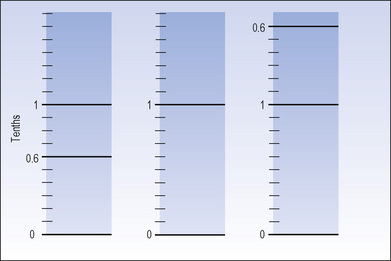CHAPTER 2 Arithmetic
Basic arithmetical principles
Numbers
Explaining fractions and decimals
The word fraction means a ‘fragment of something’.
The word decimal means ‘based on the number ten’.
Fractions may be expressed in two ways:
Fractions
‘Fractions’ are commonly used in everyday life, e.g.,
but are less often used for precise measurement.
The number above the line is known as the numerator; the number below the line is the denominator. If the two numbers are the same, they will cancel each other out to become one. So,
Decimals
‘Decimals’ are used in the metric system (see p. 10) and are measured in tenths, e.g.,
The decimal point is placed before the decimal fraction.
When a fraction is expressed in decimal form:
These figures can be illustrated on a scale, as in Fig. 2.1.
Simplifying fractions (cancelling down)
When using fractions, it is always best to simplify them as far as possible, since it is easier (and safer) to work with smaller figures than with bigger ones. For example,  could be immediately simplified by removing the zeros (dividing by 10) to give
could be immediately simplified by removing the zeros (dividing by 10) to give  , making sure of course to delete the same number of zeros above and below the line. The fraction could then be simplified by dividing the numbers above and below the line by 25 (or in two stages by 5) to give
, making sure of course to delete the same number of zeros above and below the line. The fraction could then be simplified by dividing the numbers above and below the line by 25 (or in two stages by 5) to give  . Whatever you do above the line, you must do the same below the line. Also, simplifying a fraction does not change its value.
. Whatever you do above the line, you must do the same below the line. Also, simplifying a fraction does not change its value.  (fifty over a hundred) has exactly the same value as ½ (one over two).
(fifty over a hundred) has exactly the same value as ½ (one over two).
Some exercises are given throughout the next piece of text. Answers are on pp. 193–194.
 without altering the fact that it is 6.
without altering the fact that it is 6. , often simply referred to as a ‘fraction’)
, often simply referred to as a ‘fraction’) , 1.25.
, 1.25. the class
the class of an apple
of an apple working days (whole number plus a fraction)
working days (whole number plus a fraction)






 g)
g) mm)
mm) kg)
kg)











